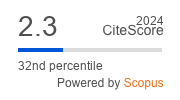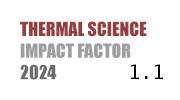THERMAL SCIENCE
International Scientific Journal
PREDICTION OF DUST CONCENTRATION BASED ON THE BOLTZMANN AND MULTIVARIATE LINEAR MODEL
ABSTRACT
In order to reduce the dust concentration in the port and ensure that the dust concentration meets the requirements of environmental protection, a combination of Boltzmann model and multiple linear regression model is proposed to predict the continuous changes in dust concentration during the loading and unloading process of imported and exported ores in the port. The quantitative relationship between port dust concentration and falling mass of mineral powder, wind speed, and moisture content of mineral powder is simulated using the Boltzmann model and the multivariate linear regression model. This quantitative relationship is an effective means of describing the change in dust concentration and reducing the port dust concentration. Moreover, the findings have the potential to enhance the quality of life for those residing in the vicinity of the port.
KEYWORDS
PAPER SUBMITTED: 2024-05-21
PAPER REVISED: 2024-07-12
PAPER ACCEPTED: 2024-07-12
PUBLISHED ONLINE: 2025-07-06
THERMAL SCIENCE YEAR
2025, VOLUME
29, ISSUE
Issue 3, PAGES [1951 - 1959]
- Lin, M. et al., Nonlinear Relationship between Urban Form and Street-Level PM2.5 and CO Based on Mobile Measurements and Gradient Boosting Decision Tree Models, Building and Environment, 205 (2021), 108265
- Yang, T., et al., Anomaly Detection of Dust Removal System through Gradient Boosting Decision Tree Algorithm, Proceedings, International Conference on Communications, Information System and Com-puter Engineering (CISCE), Beijing, China, pp. 685-688, 2021
- Wang, W., et al., Online Prediction Model Based on Support Vector Machine, Neurocomputing, 71 (2008), 4-6, pp. 550-558
- Nickovic, S., et al., A Model for Prediction of Desert Dust Cycle in the Atmosphere, Journal of Geo-physical Research: Atmospheres, 106 (2001), D16, pp. 18113-18129
- Wang, M., et al., Prediction of Road Dust Concentration in Open-Pit Coal Mines Based on Multivariate Mixed Model, Plos one, 18 (2023), 4, e0284815
- Park, S. Y., et al., Proposal of a Methodology for Prediction of Indoor PM2. 5 Concentration Using Sensor-Based Residential Environments Monitoring Data and Time-Divided Multiple Linear Regression Model, Toxics, 11 (2023), 6, 526
- Li, X., et al., Long Short-Term Memory Neural Network for Air Pollutant Concentration Predictions: Method Development and Evaluation. Environmental pollution, 231 (2017), Part 1, pp. 997-1004
- Cabaneros, S. M., et al., A Review of Artificial Neural Network Models for Ambient Air Pollution Prediction, Environmental Modelling & Software, 119 (2019), Sept., pp. 285-304
- Xu, Z., et al., Mine Dust Concentration Prediction Based on Nonlinear Autoregressive Model (in Chinese), Journal of Hebei United University (Natural Science Edition), 043 (2021), 004, pp. 127-133
- Goldstein, S., Lebowitz, J. L., On the (Boltzmann) Entropy of Non-Equilibrium Systems, Physical D: Nonlinear Phenomena, 193 (2004), 1-4, pp. 53-66
- Dubois, F., Equivalent Partial Differential Equations of a Lattice Boltzmann Scheme, Computers & Mathematics with Applications, 55 (2008), 7, pp. 1441-1449
- Duan, J., Research on PM2.5 Concentration Prediction Based on Three Prediction Models (in Chinese), Xi'an University of Electronic Science and Technology, Xi'an, China, 2023

